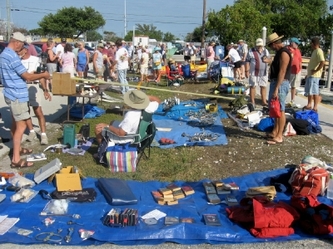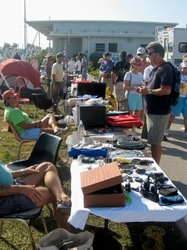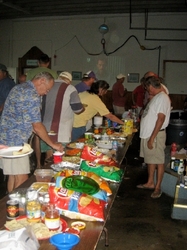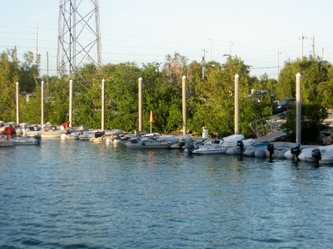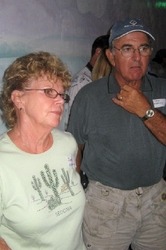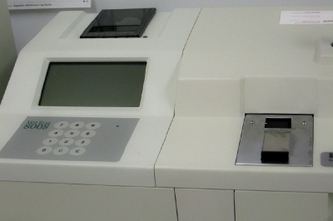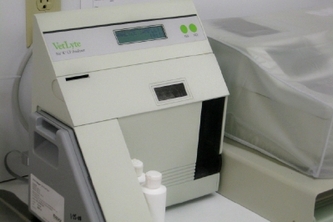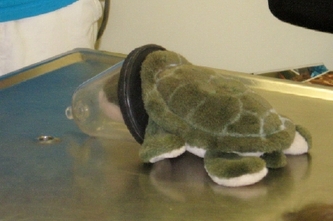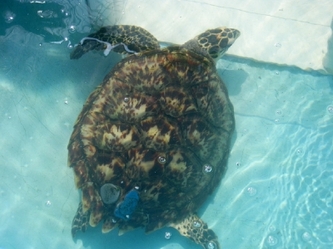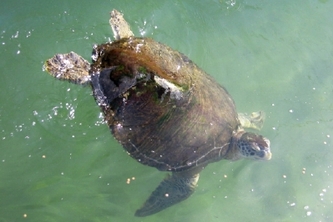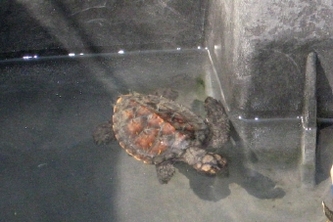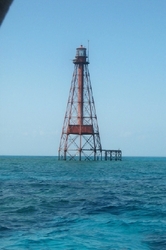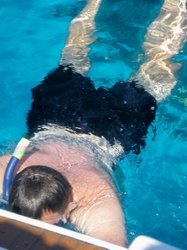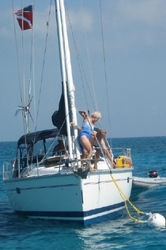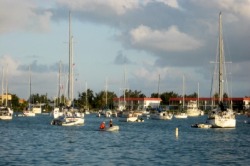
Marathon Harbor
We’ve spent the past 2 weeks in Boot Key Harbor near Marathon, Florida, about midway down the Keys between Key Biscayne and Key West. Although we originally thought this would be a shorter stay, we have enjoyed the past 2 weeks enough that we will likely stay a little longer before moving on.
Marathon - (Not so) Great Expectations
Before arriving in Marathon, we had heard lots of stories about the harbor – none of them neutral. People either loved it or hated it, but no one’s opinion was lukewarm.
There seemed to be more negative talk than anything else. A composite of the stories went something like this: From the moment they entered the harbor, people had trouble – the Boot Key lift bridge opened only once an hour and the bridge tender was completely unresponsive. After navigating the bridge, the harbor itself was dirty and full of too many anchored boats, including a lot of abandoned derelicts, to find a comfortable spot. There were a few mooring balls in place, but rarely were any available. Dockage at a marina was expensive. The community of live-aboards were hostile to the transient boaters -- and sometimes to each other – as evidenced by the sometimes abrasive talk among the participants on the morning radio net.
So what would we find when we arrived?
Our first concern before making our way to the harbor was that a mooring ball would be available when we got there. We were leery about anchoring in such a crowded harbor, if we found none. After checking with Joy on Slow Dancin’ who was already in the harbor, she confirmed that the number of available moorings was dwindling, but there were some available. We tried to have one reserved by calling the City Marina. They told us that there were a number available but said they couldn’t reserve any. We plowed ahead trying to stay confident that we would make it on one of them despite what we had heard from earlier visitors. Sure enough, before even entering the harbor, we had our mooring assignment and breathed a sigh of relief. (Within a day or so, the mooring balls became completely filled and people had to wait for them to free up. We were glad we came when we did.)
Now we just had to navigate that bridge.
Since we would have had to time our arrival carefully for a bridge that opened once an hour, we tried calling the bridge by phone to confirm its schedule. Unfortunately, the only number we had took us to the local Sheriff’s office. They said firmly that the bridge was closed. Cathy took this to be a sign that she should not be asking the Sheriff’s office about bridge schedules. When we were within a VHF range communication, we called the bridge and, to our relief, discovered that the bridge opened on request. That took the pressure off the schedule. Now we just had to get by the bridge tender. As we monitored communication with other boats, the operator seemed to be pleasant enough, but you never know. Bracing for one more of a long line of unresponsive and/or surly bridge operators along our route, Cathy called the bridge as we made our approach. We were both pleasantly surprised to hear a cordial hello, along with a chat about our boat’s name, which was one of 3 in the harbor named Orion, which included his. He opened the bridge well before we approached, let us know how to navigate the harbor and finished our conversation by welcoming us to “Paradise”. We couldn’t have asked for more responsiveness than that.
We proceeded into the harbor and continued to have one after another of the negative accounts of the harbor contradicted. The mooring fee included free dinghy dockage at a large, safe dinghy dock, access to showers, laundry, and a visit by the pump-out boat once a week. (The latter was easily increased to 2 pump-outs a week based on the small size of our holding tank.) The free pump-outs are part of a number of efforts to help clean up the harbor, which included a large trash bin and several recycling bins for everything from plastics to used diesel. We were given a nice canvas bag filled with literature about the surrounding community. The next morning’s radio net could not have been more polite, welcoming boaters, saying goodbyes, and providing the typical information exchange / trading mart that these things usually are. They went out of their way to make newcomers feel welcome, sponsoring events in the marina, such as a Super Bowl party, a flea market one Saturday and a weekly Meet ‘n’ Greet. Far from being nasty to each other, one net anchor would end the net by encouraging everyone to be nice to other boaters and to lend them a hand. We even won a free lunch at the Overseas Bar and Grill in one of the trivia contests.
Marathon - (Not so) Great Expectations
Before arriving in Marathon, we had heard lots of stories about the harbor – none of them neutral. People either loved it or hated it, but no one’s opinion was lukewarm.
There seemed to be more negative talk than anything else. A composite of the stories went something like this: From the moment they entered the harbor, people had trouble – the Boot Key lift bridge opened only once an hour and the bridge tender was completely unresponsive. After navigating the bridge, the harbor itself was dirty and full of too many anchored boats, including a lot of abandoned derelicts, to find a comfortable spot. There were a few mooring balls in place, but rarely were any available. Dockage at a marina was expensive. The community of live-aboards were hostile to the transient boaters -- and sometimes to each other – as evidenced by the sometimes abrasive talk among the participants on the morning radio net.
So what would we find when we arrived?
Our first concern before making our way to the harbor was that a mooring ball would be available when we got there. We were leery about anchoring in such a crowded harbor, if we found none. After checking with Joy on Slow Dancin’ who was already in the harbor, she confirmed that the number of available moorings was dwindling, but there were some available. We tried to have one reserved by calling the City Marina. They told us that there were a number available but said they couldn’t reserve any. We plowed ahead trying to stay confident that we would make it on one of them despite what we had heard from earlier visitors. Sure enough, before even entering the harbor, we had our mooring assignment and breathed a sigh of relief. (Within a day or so, the mooring balls became completely filled and people had to wait for them to free up. We were glad we came when we did.)
Now we just had to navigate that bridge.
Since we would have had to time our arrival carefully for a bridge that opened once an hour, we tried calling the bridge by phone to confirm its schedule. Unfortunately, the only number we had took us to the local Sheriff’s office. They said firmly that the bridge was closed. Cathy took this to be a sign that she should not be asking the Sheriff’s office about bridge schedules. When we were within a VHF range communication, we called the bridge and, to our relief, discovered that the bridge opened on request. That took the pressure off the schedule. Now we just had to get by the bridge tender. As we monitored communication with other boats, the operator seemed to be pleasant enough, but you never know. Bracing for one more of a long line of unresponsive and/or surly bridge operators along our route, Cathy called the bridge as we made our approach. We were both pleasantly surprised to hear a cordial hello, along with a chat about our boat’s name, which was one of 3 in the harbor named Orion, which included his. He opened the bridge well before we approached, let us know how to navigate the harbor and finished our conversation by welcoming us to “Paradise”. We couldn’t have asked for more responsiveness than that.
We proceeded into the harbor and continued to have one after another of the negative accounts of the harbor contradicted. The mooring fee included free dinghy dockage at a large, safe dinghy dock, access to showers, laundry, and a visit by the pump-out boat once a week. (The latter was easily increased to 2 pump-outs a week based on the small size of our holding tank.) The free pump-outs are part of a number of efforts to help clean up the harbor, which included a large trash bin and several recycling bins for everything from plastics to used diesel. We were given a nice canvas bag filled with literature about the surrounding community. The next morning’s radio net could not have been more polite, welcoming boaters, saying goodbyes, and providing the typical information exchange / trading mart that these things usually are. They went out of their way to make newcomers feel welcome, sponsoring events in the marina, such as a Super Bowl party, a flea market one Saturday and a weekly Meet ‘n’ Greet. Far from being nasty to each other, one net anchor would end the net by encouraging everyone to be nice to other boaters and to lend them a hand. We even won a free lunch at the Overseas Bar and Grill in one of the trivia contests.
Was this the same place the others were talking about?
Dave learned a little more firsthand about the evolution of Boot Key Harbor from purgatory to paradise as he talked to one of the live-aboard boaters at the Super Bowl party. At the event, Dave offered to help grill hamburgers and hot dogs, which pleasantly surprised Larry, a local boater. In the course of their conversation, Dave learned the high turnout at the Super Bowl party, which included many live-aboards and transients, had shocked the locals. This was because all the negative stuff that what we had heard from the past was true.
Dave learned a little more firsthand about the evolution of Boot Key Harbor from purgatory to paradise as he talked to one of the live-aboard boaters at the Super Bowl party. At the event, Dave offered to help grill hamburgers and hot dogs, which pleasantly surprised Larry, a local boater. In the course of their conversation, Dave learned the high turnout at the Super Bowl party, which included many live-aboards and transients, had shocked the locals. This was because all the negative stuff that what we had heard from the past was true.
The efforts by the city to clean up the harbor and put in mooring balls had been fought tooth and nail by the locals, who were genuinely hostile to the transients – and vice versa. But at some point, the general decision was that this was going to happen, so rather than fight, many locals joined the effort. The change in attitude along with the physical changes to the harbor had brought more visitors and had generated some new jobs. Larry was now employed in the harbor, helping to install and maintain the moorings. Anchoring was still possible, but was now managed, along with the moorings, by the City Marina. Having a boat in the harbor was still an affordable way to live in the Keys, and the quality of life was now improving as well.
They seemed to be doing it right. There is still some more work to be done – most significantly, completing the new shower house -- but it’s hard to find much that is negative to say now about this welcoming community in the protected Boot Key Harbor.
Now you know why we’re still here.
Now you know why we’re still here.
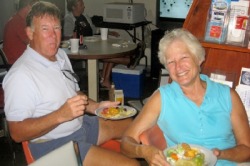
Joy and Rusty from Slow Dancin'
Things Ashore
We enjoyed reconnecting with Joy and Rusty on Slow Dancin’, Tom and Cathie on Interlude, and Dave and Barb on Fortunate, who had all arrived together near the early part of January. They helped orient us to the harbor, including showing us the tricky “dinghy shortcut”, which is a more direct route to the dinghy dock, but requires some navigation to avoid a seriously large shoal. We met them ashore for pizza on our first night there and then joined them in a series of shore excursions.
We enjoyed reconnecting with Joy and Rusty on Slow Dancin’, Tom and Cathie on Interlude, and Dave and Barb on Fortunate, who had all arrived together near the early part of January. They helped orient us to the harbor, including showing us the tricky “dinghy shortcut”, which is a more direct route to the dinghy dock, but requires some navigation to avoid a seriously large shoal. We met them ashore for pizza on our first night there and then joined them in a series of shore excursions.
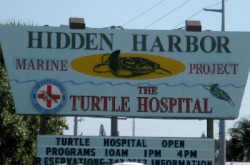
Turtle Hospital with sign for the now closed motel that started it.
One of these was a visit to the Turtle Hospital, a veterinary hospital for sea turtles. Originally, it was a motel with a salt water pool, to which the owner wanted to add a sea turtle. This led to an understanding of the plight of the sea turtles and the beginning of the Turtle Hospital. Until 2005, the motel remained in business, helping to fund the hospital. With the series of hurricanes that year, the motel business was closed down and the hospital turned all of its attention to the turtles, seeking donations for its continued work.
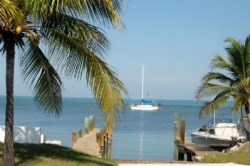
View from gulf side of the island
There were about 20 sea turtles, representing 4 of the 5 species that inhabit the area, in residence at the hospital. These were at various stages of rehabilitation, including some who would not be able to be released again due to their injuries. Examples of turtle injuries were varied and mostly of human origin -- fishing line around flippers which usually required amputation, deformed shells as a result of collision with a boat hull (called “bubble-butt” due to the trapped air, which prevented them from diving), severely impacted colons due to the ingestion of plastic made materials, and an occasional shark attack. The population has peaks and valleys, based mainly on the boating season. When boaters are more likely to be out, more turtles are spotted and rescued.
We also discovered several restaurants ashore, including Keys Fisheries, a seafood eatery on the gulf side of the island, with a great lobster reuben, and Hurricanes, a sports bar with 25 cent wing night on Thursdays.
Snorkeling
We also discovered several restaurants ashore, including Keys Fisheries, a seafood eatery on the gulf side of the island, with a great lobster reuben, and Hurricanes, a sports bar with 25 cent wing night on Thursdays.
Snorkeling
We made our first trip to a reef to go snorkeling on Orion, (previously we have gone snorkeling from shore). There were mooring balls at the Sombrero Key Light, only about an hour away. We joined Slow Dancin’ to pick up one of the mooring balls and snorkel on the reef. You could jump in the water and be surrounded by fish. The reef headed out in all directions, so it was easy to find something to see – parrotfish, blue tangs, damsels, barracuda, etc. The water was very clear, but the swells made it a little bouncy. (You are, after all, in the Atlantic Ocean, even if the winds are light.) Not all mooring balls are created equal however. Slow Dancin’ took a look at the distance between her keel and the reef below it and decided to move to another ball. It was a little too close for comfort.
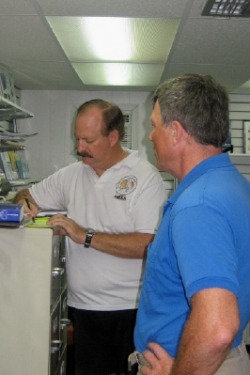
Boat Stuff
After spending time snorkeling at Sombrero Reef, Dave became even more obsessed with finding a way to clean the bottom of Orion after seeing the stuff growing on it. He was interested in a system like the one Rusty and Joy used on Slow Dancin’. Called a “hooka” system, it provides compressed air using a compressor that feeds a line down to the person underwater, who breathes using a regulator, common to any standard scuba gear. This eliminates the need for tanks of compressed air, which would have to be refilled. After looking for this kind of system in various dive shops and through a local guy with a small business selling them, Dave realized he could use a simple compressor sold at the nearby Home Depot. This was actually part of some of the systems he had seen advertised. He just needed the rest of the kit – hose, regulator, belt -- and he could make it work.
After spending time snorkeling at Sombrero Reef, Dave became even more obsessed with finding a way to clean the bottom of Orion after seeing the stuff growing on it. He was interested in a system like the one Rusty and Joy used on Slow Dancin’. Called a “hooka” system, it provides compressed air using a compressor that feeds a line down to the person underwater, who breathes using a regulator, common to any standard scuba gear. This eliminates the need for tanks of compressed air, which would have to be refilled. After looking for this kind of system in various dive shops and through a local guy with a small business selling them, Dave realized he could use a simple compressor sold at the nearby Home Depot. This was actually part of some of the systems he had seen advertised. He just needed the rest of the kit – hose, regulator, belt -- and he could make it work.
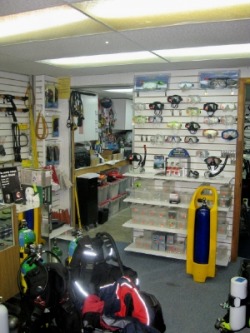
MDEA's Shop
Luckily for him, he walked into a dive shop in the back of a nondescript building on US 1, which actually turned out to be MDEA, a manufacturer of dive equipment, with a small retail side. Wayne, the owner, was interested in the system Dave wanted to put together. He could provide the scuba gear for a very reasonable price (half that of the other quotes Dave had received) and confirmed the minimum and optimal performance requirements for the compressor. He readily agreed to work with us, if we bought the compressor, including helping us with some transportation in moving it from place to place, since we were on foot.
On a rather rainy day, we made our way into shore to get the final instructions on using the new equipment. Unfortunately, the compressor, which had worked so well when Wayne was testing it the day before, failed to hold pressure due to a faulty regulator knob. Wayne then drove us to Home Depot to exchange it, only to discover they had no more in stock. Since there were some in Key West, we paid for one there and had them hold it for us to pick it up the next day. In the meantime, Wayne took us back to his shop, where he could demonstrate the regulator on some of his equipment, so we would know how to use it – both the person in the water and the person watching the system on deck. He was a great instructor and our experience working with him couldn’t have been more positive.
Getting a working compressor proved to be a bigger challenge. Moving something this big around is its own headache. Since it must stay dry, we have to cover the box with a plastic bag and put it in the dinghy without any other passengers or stuff. It takes a solo trip across the harbor to (or from) the dock. Then we load it on a cart and haul it to its destination. Since we had to travel to Key West to get the replacement, this added the dimension of loading it on and off the bus.
On a rather rainy day, we made our way into shore to get the final instructions on using the new equipment. Unfortunately, the compressor, which had worked so well when Wayne was testing it the day before, failed to hold pressure due to a faulty regulator knob. Wayne then drove us to Home Depot to exchange it, only to discover they had no more in stock. Since there were some in Key West, we paid for one there and had them hold it for us to pick it up the next day. In the meantime, Wayne took us back to his shop, where he could demonstrate the regulator on some of his equipment, so we would know how to use it – both the person in the water and the person watching the system on deck. He was a great instructor and our experience working with him couldn’t have been more positive.
Getting a working compressor proved to be a bigger challenge. Moving something this big around is its own headache. Since it must stay dry, we have to cover the box with a plastic bag and put it in the dinghy without any other passengers or stuff. It takes a solo trip across the harbor to (or from) the dock. Then we load it on a cart and haul it to its destination. Since we had to travel to Key West to get the replacement, this added the dimension of loading it on and off the bus.
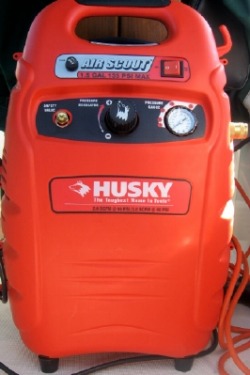
Husky air compressor (the one that worked) from Home Depot
After returning from Key West with the new compressor and hauling it back to the boat, it failed with the same problem within a few minutes of starting it up. Frustrated, Dave called the manufacturer the next morning to learn that this was a known defect in a number of units. They wanted to send him a repair kit, but this could be problematic, if we moved on as planned. Instead he took the compressor back to Home Depot in Marathon, and, by talking to several persons in both Marathon and Key West stores, he finally managed to get a unit that worked brought from Key West to Marathon. (They actually had to send it via an employee who worked in Key West, but lived in Marathon.) Once this one was back on the boat, we fired it up and it worked just as it was supposed to.
Dave proceeded to use it immediately, diving down to clean a lot of the growth off the bottom, cleaning the thru-hulls as well. It worked like a charm. This unit will likely see a lot of use while we are here in the warmer -- and clearer -- water.
Dave proceeded to use it immediately, diving down to clean a lot of the growth off the bottom, cleaning the thru-hulls as well. It worked like a charm. This unit will likely see a lot of use while we are here in the warmer -- and clearer -- water.
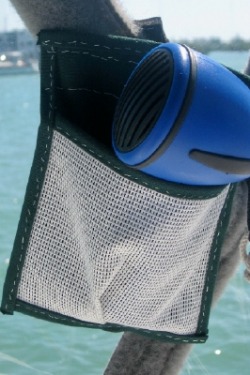
New horn pocket for cockpit
Compared to this major enterprise, the other projects were much less significant. Cathy made a small pocket to hold the horn in the cockpit. Dave managed to order some o-rings to replace one that seemed to be failing in the Vetus raw water strainer. Through some negotiations, he managed to get them to sell him just a package of o-rings, instead of insisting he buy a whole new top for the unit, which would have been ten times more expensive, and unnecessary. The new o-ring seemed to do the trick and the air bubbles in the strainer had disappeared.
Where to now?
We still have more to see in Marathon before moving on, so it’s not clear when that move will take place. We’re still thinking about going to Key West and the Dry Tortugas before we turn around to head north again. In the meantime, we’ll enjoy this sojourn in “Paradise”.
Where to now?
We still have more to see in Marathon before moving on, so it’s not clear when that move will take place. We’re still thinking about going to Key West and the Dry Tortugas before we turn around to head north again. In the meantime, we’ll enjoy this sojourn in “Paradise”.
